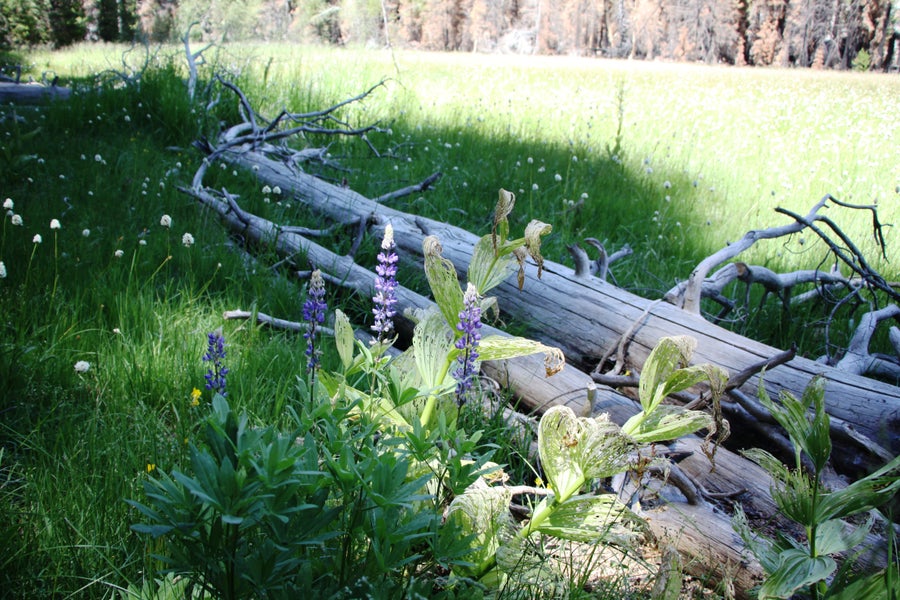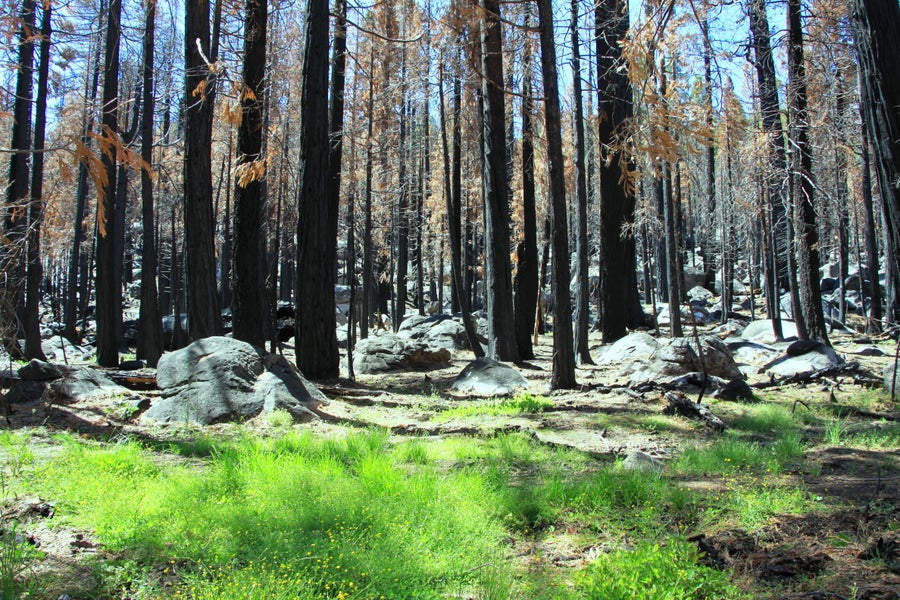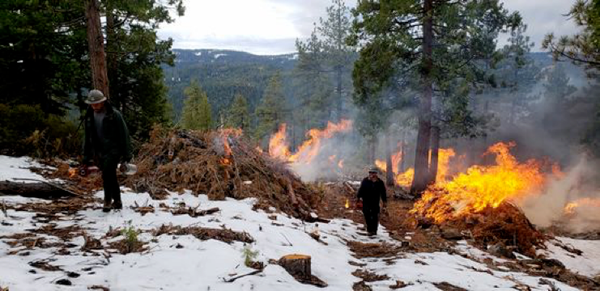Kyburz, Calif.—Near the top of a 7,000-foot ridge in California’s Sierra Nevada, crews wielding gasoline-dripping torches began igniting piles of small logs and branches on an unusually cold morning late last September. Ignoring snow flurries and light rain, they trudged from one pile to another, nursing the flames that licked into pine needles and twigs on the surrounding ground and monitoring small trees that flared up like bonfires.
The fire starters worked their way down the mountain north of Caples Creek over the next week, their blazes efficiently controlled with the help of “lanes” that had been cleared of forest debris. They supervised flames racing across meadows that, remarkably, had not burned since at least 1916. Crews paid particular attention to the largest Jeffrey and ponderosa pines, some of them 300 years old. These trees had been protected in advance by volunteers, who had removed shrubs and raked fuels away from trunks that were more than 30 inches in diameter. By the time the flames were out, the Caples Ecological Restoration Project had burned 3,435 acres in the mountainous watershed of Eldorado National Forest, 70 miles east of Sacramento—part of an area that provides the primary water supply for more than 110,000 people. It was the largest intentional fire ever set in the Sierra Nevada and one of the largest on federal land in the state.
The effort marks a milestone in California’s pivot away from a century of suppressing fire at all costs and toward working with it instead—using controlled flames to restore ecosystems that evolved to burn in frequent, mostly low-intensity blazes. Suppression has left forests throughout the West unnaturally crowded with small trees and shrubs—ready tinder for larger, far more damaging conflagrations. California’s forests are even more vulnerable because more than 147 million drought-weakened trees have died statewide since 2010, leaving them primed to burn. Because of these and other factors, such as poor management practices and warmer temperatures from climate change, the extent of fires that escape even the most aggressive suppression has increased fivefold over the past five decades. Scientists say tangled masses of ultradry fuel represent a fire hazard of unprecedented size and intensity if left alone. Blazes this year, including the Lake Fire in the mountains north of Los Angeles and the L.N.U. Lightning Complex west of Sacramento, have already burned 30 percent more than the acreage flames blackened across California last year, stretching firefighting crews thin and prompting Governor Gavin Newsom to declare a state of emergency.
On supporting science journalism
If you're enjoying this article, consider supporting our award-winning journalism by subscribing. By purchasing a subscription you are helping to ensure the future of impactful stories about the discoveries and ideas shaping our world today.
U.S. Forest Service officials had been planning the Caples prescribed burn for five years—nervously hoping the forest would not go up in flames sparked by lightning or a careless camper before they could implement their meticulously designed, scientific burn strategy. “This is all about reintroducing fire back into the landscape: restoring that vital natural ecosystem process, which will ultimately slow the spread of wildfire,” says Jeff Marsolais, Eldorado’s forest supervisor.

Nine months after this meadow burned, purple lupines line the edges and sheer-white bistort fill the open expanse between burned trees. Credit: Jane Braxton Little
Planned and Unplanned
In 2011 Eldorado forest officials identified the steep, granite-strewn slopes of the Caples Creek area as a priority for restoration efforts that would gradually reintroduce fire and restore the meadows dotting the pine and fir forests. Funded by a $477,000 Sierra Nevada Conservancy grant, the plan scientists developed involves 8,800 acres of prescribed burning over 15 years to reduce the heavy load of flammable low-lying vegetation. Along with preventing huge and uncontrollable wildfires, they aim to reestablish forests healthy enough to allow small fires to burn unimpeded. The path of the Caples prescribed burn was designed to promote a mixture of species in a mosaic, with large openings between tree stands where fire could occasionally burn undergrowth without damaging large trees. “We wanted to reintroduce fire where it would bring the greatest benefits and inflict the least harm,” says Forest Service ecologist Becky Estes, who designed the monitoring plots in the Caples burn.
Not everything in the project went as envisioned. Unexpected high winds roared through the area 10 days into the carefully calculated plan, blowing the intentional fire out of the 1,080-acre designated zone and into forests that had not been prepared for burning. Eldorado forest officials brought in suppression crews, halting the escaped fire after it burned through 2,355 acres.
Such glitches are part of the learning process as forest managers try bringing fire back to the Sierra Nevada after 100 years of fighting it off, says Tony Scardina, deputy forester of national forests in California. “We understand that when we’re managing fire, whether it’s a wildland or a planned fire, there’s always risk,” he says. But Scardina is undaunted. “We remain committed to bringing those ecosystems back to a resilient state in a planned, careful and controlled manner,” he says. “And we are committed to applying what we learned from this situation to continuously improve our prescribed fire program.”
Checking In
Scardina and others had to wait for winter snows to melt—and for Forest Service officials to come up with COVID-19 pandemic protocols that made it safe for a group of scientists to inspect the burned area to see what was growing come spring. Nine months after the fire, the trail along Caples Creek climbs through gray granite boulders and purple lupines blooming among charred logs. Blackened tree trunks rise out of thick grass carpets, and the sun filters through a canopy of conifer needles, half of them green, half of them scorched rust-red. Helen Payne, a botanist in Estes’s ecological field-monitoring crew, is on her hands and knees just off the trail on a hot July morning, examining a spindly cedar tree with black burn streaks on its trunk. Behind her, fire-felled pines the size of utility poles are toppled against trees that are still standing but weakened by fire, likely to fall in the next big storm. The ground is littered with dry needles sprinkled across the ashes of last year’s burn.
Payne is taking inventory of every detail within an area about the size of a home swimming pool: the presence of seedlings, flowering plants and fungi, as well as the size and number of trees and whether they are healthy, scorched or fire-killed. This plot is one of 105 that Estes established before the burn to monitor its effects on as much of the vegetation as possible—every five years for the foreseeable future. Payne points to a tiny seedling, its trunk no thicker than darning thread but somehow supporting the fragile fronds of new life. “We found two,” she says, clearly excited by the speed of rejuvenation.
Data collected at 46 monitoring plots in a November assessment have provided information about the immediate effects of the fire. Despite intense burning in some places and an extra 2,355 acres catching fire, the experiment generally produced healthier forests, says Scott Dailey, one of the Forest Service ecologists who conducted the assessment. Before the burn, eight-inch-diameter saplings were nearly triple the density scientists believe a resilient forest should harbor. These small trees ignite easily, providing a ladder for fire to climb into the tops of large ones. The part of the blaze that got away actually cut their number to a more sustainable density—and the intentional fire did not reduce them as much as officials would have liked, Dailey says. The prescribed burn did not kill any trees greater than 30 inches in diameter, but these centuries-old survivors did not fare so well in the escaped wildfire. Among the plots he surveyed in that area, Dailey found nearly 25 percent fewer large trees after the fire.
The prescribed burn effectively reduced the ground litter under trees, where wildfires generally start, knocking the average litter depth down from around two inches to less than half an inch. The wildfire was even more effective: nearly two and a half inches of duff were reduced to around one third of an inch. Overall, the combined Caples planned burn and inadvertent wildfire produced forests much closer to natural conditions, Dailey says. Still, there was some damage: The bulldozers brought in to control the escaped flames left scars on the forest floor. And trees were haphazardly strewn about some areas, because firefighters had to fell them to suppress the blaze.
One of the lessons Caples taught managers is the crucial role of meteorology, Marsolais says. No one predicted the winds that blew the fire beyond the planned area. “Our forecasting has only so much capability. We’re focusing now on how good predictions can be,” he says. The burn also made clear that many forests in the Sierra Nevada are simply too crowded for fire to return without the extraordinary effort that went into preparing the Caples area. “You can’t just put fire back on the landscape,” Marsolais says.

Fire, absent in this pine stand for over a century, rejuvenates the grasses and other plants, which thrive on the surge of nutrients it provides. Pine needles were scorched rust-red by the prescribed burn. Credit: Jane Braxton Little
Small but Important Step
The Caples prescribed burn is an important first step—but a small one—in a long march toward restoring forest resilience, says Malcolm North, a U.S. Forest Service scientist at the Pacific Southwest Research Station. He studies Sierra Nevada forests but was not involved in the Caples burn. To return forests to their original state (in which they survive and benefit from natural fire), he says crews would have to burn 500,000 acres a year on the five million acres the Forest Service manages in the Sierra Nevada. The agency’s “fuels reduction” goal for this year is 230,000 acres, including just 60,000 acres of prescribed burning. For the rest, chain saws and other mechanical equipment will be used to thin trees. “Whatever we can do to change the pace and scale of prescribed burning, that’s the 99.9 percent priority,” North says.
Forest resilience has implications for most of California’s residents. The effects of unhealthy forests have proliferated, particularly following the devastating wildfires of 2018. Homeowners’ insurance rates doubled and tripled for those lucky enough to get policies at all. Too many people have experienced the terror of wildfires bearing down on them, forcing last-minute evacuations and taking dozens of lives. Most pervasive, however, are the effects of the smoke that smothers cities, small towns and rural areas alike, increasing the risk of asthma and other respiratory problems.
Public acceptance of smoke is one of the greatest challenges facing the drive to return natural fire to the Sierra Nevada’s forests. Prescribed burns do emit smoke—but the smoke from wildfires carries far more toxic ingredients from burned homes and vehicles, Marsolais says. Craig Thomas, former executive director of Sierra Forest Legacy, a nonprofit conservation group, calls smoke a trade-off. He has engaged air resource officials through a multiparty collaboration to improve coordination between the management of fire and public health. Because California’s Sierra Nevada forests have a natural propensity to ignite, whether as wildfires or controlled burns, Thomas says, “we either work with fire, or it eats our lunch.”
Eldorado forest officials will continue to study the effects of the Caples burn as they prepare for the next prescribed fire, likely in an adjacent area in 2021. Restoring forest health and ecosystem values at a meaningful scale is a long-term process, Marsolais says. “We cannot let up,” he adds. “Uncontrolled wildfire is knocking on the doors of these communities.”
